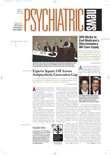The intricate interplay between pain and depression has been observed for years. For instance, pain worsens depression; depression worsens pain. Persons with a number of pain symptoms are at an elevated risk of developing depression. And depression appears to be a significant risk factor for back pain (Psychiatric News, April 2, 2004).
Now a new study has found that people who are depressed and also in pain may be slower to respond to treatment than if they were only depressed.
The study was headed by Jordan Karp, M.D., a physician-investigator fellow at the University of Pittsburgh's Center of Excellence in Geriatric Psychiatry. Results appeared in the May Journal of Clinical Psychiatry.
Karp and his colleagues enrolled 230 persons with recurrent unipolar depression in their study. These individuals had to meet Research Diagnostic Criteria for a major depressive episode and to have had at least three previous major depressions with clear remissions between. They also had to have a score of at least 15 on the Hamilton Rating Scale for Depression and a score of at least 7 on the Raskin Severity of Depression Scale.
Each subject was given the Hopkins Symptom Checklist to determine whether, during the previous week, he or she had experienced somatic symptoms such as dizziness, nausea, or tingling in the body or specific types of pain such as headache, chest, or lower-back pain.
Subjects were then started on an antidepressant and psychotherapy—150 mg to 300 mg of imipramine daily and interpersonal psychotherapy weekly for 12 weeks, then biweekly for eight weeks, and then monthly. (The reason why subjects received imipramine rather than a newer antidepressant, Karp explained to Psychiatric News, is that this study is a secondary analysis of material derived from another study they conducted in the late 1980s, when imipramine was an antidepressant of choice.)
The Hamilton Rating Scale for Depression and the Raskin Severity of Depression Scale were used to assess the subjects for remission from depression. Remission was defined as achieving both a Hamilton score of 7 or lower and a Raskin score of 5 or lower for three consecutive weeks.
The researchers then looked for relationships between subjects' initial somatization and pain scores and how long it took the subjects to achieve depression remission. Higher levels of pain and somatization predicted a longer time to remission, but after controlling for the baseline severity of depression, they found that only pain was still significant in predicting a longer time to remission.
Karp and his co-workers do not have a firm explanation for this latter finding. “It could be that pain indicates an undiagnosed medical condition that needs to be addressed,” he said. “For example, rheumatologic diseases are prevalent disorders and are often comorbid with mood disorders. Perhaps these disorders were untreated, slowing the treatment response of the depression. In addition, some of the somatic symptoms may be associated with the depressive syndrome, while pain represents a different process that requires a unique treatment approach.”
In any event, “Pain, not somatization, predicted a longer time to remission and may be a marker of a more difficult-to-treat depression,” Karp and his team concluded.
This finding, they pointed out, is also “clinically useful, because patients who report more pain prior to receiving antidepressant treatment, for example at their initial psychiatric evaluation,... may require more aggressive treatment, or longer treatment, to achieve remission.”
The study was funded by the National Institute of Mental Health.
The study, “Pain Predicts Longer Time to Remission During Treatment of Recurrent Depression,” is posted online at<www.psychiatrist.com/privatepdf/2005/v66n05/v66n0508.pdf>.▪
